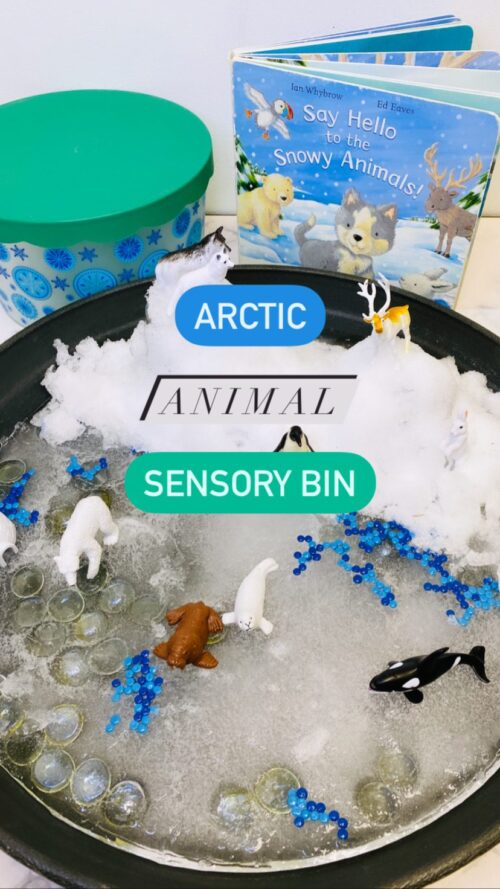As a teacher, you’re always looking for fun and engaging ways to help your students develop their language skills. Sensory bins are an excellent tool for this purpose. Not only do they provide a tactile experience, but they can also target a wide range of language goals. In this blog post, we will explore how an Arctic animal-themed sensory bin can help your students practice following directions, prepositions, and new vocabulary. I love including books with my sensory bins and using the book “Say Hello to the Snowy Animals” was perfect for my arctic animal-themed bin!
This post may contain affiliate links, which means I may receive a commission, at no extra cost to you, if you make a purchase through a link. Please see my full disclosure for further information.
Creating the Sensory Bin
To create an Arctic animal-themed sensory bin, you’ll need a few materials. Start with a plastic bin or tray. Fill it with a base material such as white rice, cotton balls, or snow made from baking soda and shaving cream. I live in Utah and was fortunate enough to be able to add water to my tray, set it outside, and let it freeze. I then added some real snow to my bin. Then add some arctic animal figurines, such as polar bears, penguins, seals, and arctic foxes. I got these Toob Arctic Animals that were perfect for my bin. You can also add other items such as plastic trees, igloos, and rocks to create a realistic Arctic environment.

Following Directions
Sensory bins are an excellent tool for practicing following directions. Give your students instructions such as “Find the polar bear and put it on the igloo” or “Put the penguin next to the rock.” You can also make it more challenging by giving multiple instructions at once, such as “Find the seal and put it on the blue rock, then put the polar bear in front of the igloo.”
Prepositions
Prepositions can be a difficult concept for students to understand. Using a sensory bin can make learning prepositions more concrete. You can give instructions such as “Put the penguin under the tree” or “Put the seal in front of the igloo.” As your students move the animal figurines around the sensory bin, they will gain a better understanding of prepositions and how they are used in language.
New Vocabulary
Using an Arctic animal-themed sensory bin is a great way to introduce new vocabulary words. As your students play with the sensory bin, they can learn the names of different arctic animals and their characteristics. You can also introduce words such as “blubber” and “hibernate” as you talk about how arctic animals survive in their environment.
Using the Book “Say Hello to the Snowy Animals”
Incorporating a book into your sensory bin can enhance the learning experience for your students. “Say Hello to the Snowy Animals” by Ian Whybrow is an excellent book to use with an Arctic animal-themed sensory bin. The book introduces different arctic animals and their habitats. As you read the book to your students, they can play with the sensory bin and act out the different animal habitats.
Sensory bins are a great tool for helping your students develop their language skills. An Arctic animal-themed sensory bin can be used to practice following directions, prepositions, and new vocabulary. Incorporating the book “Say Hello to the Snowy Animals” can also enhance the learning experience. So gather your materials, create your sensory bin, and watch your students have fun while learning!

